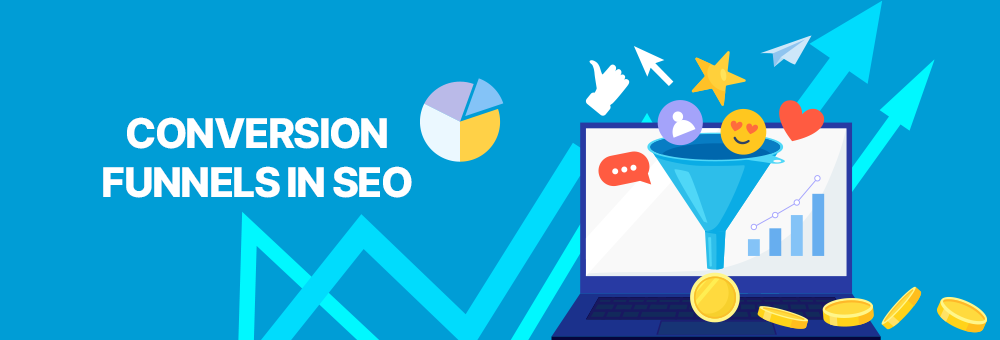Achieving top placement on Google through SEO helps enhance a website’s visibility and boost its ranking in search results. Honestly, it’s an amazing feeling to see that you’re number 1 for one or several keywords.
However, SEO is not the end goal, but rather the means to achieve something more.
You need to turn those visitors into customers. Because once you’ve reached the top, what’s next? You run a business, and I assume you don’t live on air.
Therefore, once you’ve secured those coveted positions within Google’s SERP, you need your visitors to purchase your products or engage your services.
That’s exactly why you’re here: to learn how to achieve better conversion through SEO and use it as a conversion funnel so that the increase in organic visibility goes hand in hand with an increase in conversions for your business.

If you’re up for discovering how to accomplish this, stick around, and I’ll tell you more.
What is a Conversion in SEO?
Let’s start by defining what a conversion in SEO is.
A conversion can be defined as the achievement of a set goal at a specific stage in the marketing or sales process.
A goal could be to make a sale, in which case the conversion would be sales, but that’s not the only possibility.
- Making a purchase
- Filling out a form
- Signing up for the site
- Downloading content
- Watching a video or spending a certain amount of time on a page
I think it’s important to clarify the concept of ‘conversion’, as most people tend to think that “conversion = sale”.
The sale is the ultimate goal. But we can also say we’ve converted when we achieve any of the points mentioned above.
And if you apply the concept of conversion to the realm of SEO, it translates to the achievement of the set goal at a stage through the organic traffic your website receives.
That is to say, originating from a search conducted through Google or another search engine.
Now that you have a clear understanding of what an SEO conversion is, we can take it a step further and consider creating an SEO conversion funnel.
I propose developing a strategy where SEO is the vehicle that drives your potential customers towards conversion.
This way, you’re going to ‘make the connection’ you’re looking for. But let’s see what exactly this means.
What is an SEO Conversion Funnel?
The conversion funnel or sales funnel is a series of stages that occur from the acquisition of a customer to the purchase and subsequent loyalty building. At each of these stages, we’ll encourage them with the help of SEO and specific types of keywords, among other things.
It’s often called a funnel because as potential customers progress through stages, we guide them to the next one, and the funnel narrows more and more (the number of people moving from one stage to the next decreases).

It’s obvious that our goal is to prevent the consumer from dropping out of the conversion funnel during this process.
How can you ensure that the consumer continues advancing through the stages of the SEO conversion funnel?
Alright. Now that you understand what an SEO conversion is and its purpose, it’s important for you to know how you can stimulate each stage.
Keep in mind that you cannot aim to generate the same conversions for all users.
Let me give you an example:
Imagine yourself as someone who searches on Google for “what is SEO and what is it for” and lands on an article on your blog.
This content is a beginner’s guide that addresses the need that brought them to you (they didn’t know what it was or what it was for).
The key I want you to understand is that:
It will be very difficult to sell an SEO Master’s program to someone who doesn’t yet know what it is or its benefits. It’s more feasible to invite them to subscribe to your SEO newsletter.
You could send them practical tips weekly so they can learn little by little.
The conversion here should not be the sale of the training, because they are in the initial phase of the sales funnel.
It’s much better to have that lead in your database and periodically make an impact on them so that they continue learning.
Maybe after some time, they’ll get the itch to take the leap and professionalize that knowledge. But not at the current stage.
How can I know how many users move from one stage of my conversion funnel to the next?
To find out how many of the users that come to your website go on to the next stages of the conversion funnel of your business or ecommerce, there is a quick and easy way to find out:
If you connect and synchronize DinoRANK’s “Business” Module with your Google Analytics 4 and your Tag Manager account, you can add all these phases to your funnel.
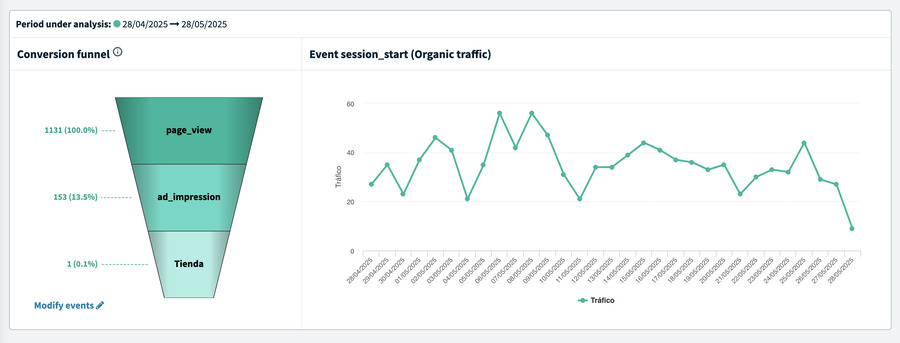
The tool tells you how many users moved from one phase to the next. This way you can detect where there might be any “plugs” or bottlenecks.
In addition, it offers you a table where you will know which URL’s are the ones that bring the most conversions to your business.
Phases of the SEO Conversion Funnel
As you can see, the funnel is divided into various phases or stages where consumers will be more or less qualified.
The consumer profile according to the phase is as follows:
1. Awareness
This is also called “Brand Awareness.” Here, many consumers may not be aware that they have a problem or need, or they may just be starting to recognize it.
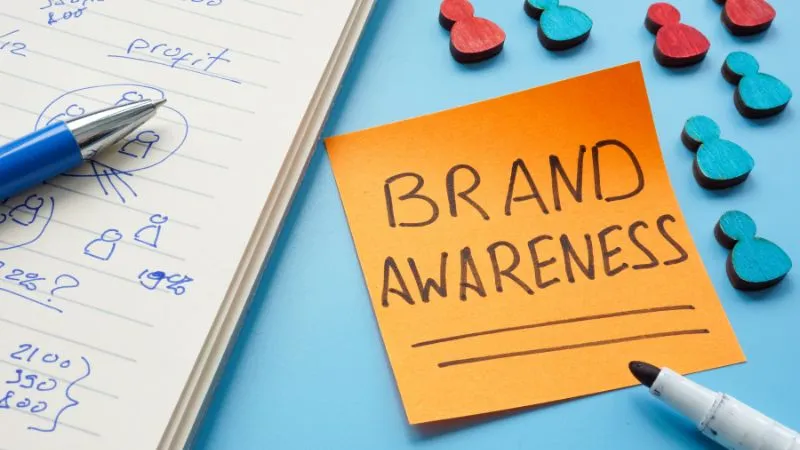
Their interaction with content is more exploratory and educational.
- Needs: They are looking for general information, answers to basic questions, and education on topics relevant to their problems or interests.
- Expectations: They expect content that is easy to digest and is informative and helpful, without feeling pressured towards a sale.
The SEO strategy for awareness should go along these lines. Apply psychology and understand that those who are here are not yet ready to buy.
But if we push them in the right way, they’ll move on to the next phase:
2. Consideration
At this stage, the consumer is familiar with your brand, but they don’t have much information about it.
From my experience, this is the toughest and longest stage.
You must charm the user to choose you over the competition, giving them reasons to do so.

Sounds like a tough gig, right? Well, indeed it is.
But, just like me, I sense you’re up for a challenge. That’s why we’re going to leverage SEO along with other marketing efforts, because it’s all about turning a ‘barely interested user’ into a ‘brand consumer’.
I assure you it requires a lot of hard work but it’s extremely rewarding when you achieve it.
3. Action or Decision
At this point, the consumer is already convinced they want to purchase the product or service you offer.
Their only question is whether to go with you or your competition.
Therefore, you need to give them that final nudge to tip the scales in your favor, giving them ample reasons to make you the chosen option and to take action.
The person will now see you as a trustworthy and approachable brand.
4. Loyalty
After the sale, don’t think it’s all over. It’s time to keep the ball in your court.

You’ve got their attention and their approval, which was the hardest part, right? Now, make them loyal.
In this phase of the SEO conversion, you must seek the consumer’s repeat business.
Consumers are looking for a great experience with your product or service to confirm their decision and to think of your brand in the future.
The goal is for them to think of you as the first option when they need a product or service like the one you offer again.
In marketing, it’s often said that it’s easier to sell something else to an existing customer than to try to do so with someone who hasn’t bought from you yet. And when it comes to services, from personal experience, I can vouch for that.
Additionally, a happy customer can become a brand advocate, recommending it to their friends and family.
What role does SEO play in this conversion stage?
Organic ranking plays a key role in guiding consumers throughout the process.
There may be people who tell you that SEO is only good for awareness and consideration.
But the strategies I’m going to give you if you keep reading will speak for themselves. You’ll see shortly.
How to create a content strategy based on the SEO conversion funnel stage?
Now that you know the theory, it’s time to put into practice everything we’ve learned about the SEO funnel.
Let’s work together on a strategy that optimizes conversions through organic ranking.
For this, you need to fully understand the Customer Journey that exists at each stage.
Let’s use the example of hiking. We have an online store for clothing and gear for those who love this physical activity.
Join me. We’re going to move from one phase to the next thanks to SEO conversion and the right keywords:
Phase 1: Awareness Strategy
In this phase, the consumer (let’s call him Miguel) is still quite far from making a purchase.
He’s a 29-year-old freelance digital marketing consultant who spends at least 10 hours a day sitting in front of a computer and frequently suffers from back pain, despite his young age.
His sedentary lifestyle has led him to have poor eating habits and to be ‘a bit’ overweight.
Moreover, Raquel, his partner, works with him and therefore they have very similar habits. They both are from San Diego and work Monday to Friday.
Miguel is aware that he needs to start changing his habits, and here are some examples of searches he might perform:
- How to be less sedentary?
- Weekend sports activities
- Sports to do as a couple
- How to lose weight without too much effort
- Sports to enjoy the great outdoors
- Where to exercise outdoors in San Diego
At this stage, Miguel still doesn’t know that hiking could be a potential solution.
What should I do to signal to him that he needs to give it a try?
Right now, the key is to create content on our corporate blog using the right keywords to address some of those previous search intents.
You should present him with options where this physical activity is always a viable alternative to the solution he’s looking for.
This phase aims to ‘ignite’ the spark in him that shifts his focus to hiking.
Important: I recommend that you keep track of all the keywords you believe could be relevant in this stage and the following ones in a spreadsheet.
It will be an ideal brainstorming session to serve as a starting point for the content in each stage of the SEO conversion funnel.
What keywords should I use to boost conversions?
My advice is to start working with long-tail keywords. These often have (in most cases) a search volume that’s not too high.
The advantage is that they will have less competition and we can appear sooner on Google’s SERP, as long as we build strong, valuable content.
Let’s head over to DinoRANK. We’ll see it more clearly there:

- Log in with our account and go to the “Content SEO > Keyword Research” section
- In the “Keyword to investigate” search bar, type in the keyword we want to gather information on. Make sure the country and language are set to United States/English respectively
- Choose whether you prefer DinoRANK to offer you AI recommendations (or not).
- Click on “Search” and DinoRANK will return its search volume
And if you chose to get AI recommendations for other keywords, you will see it like this:
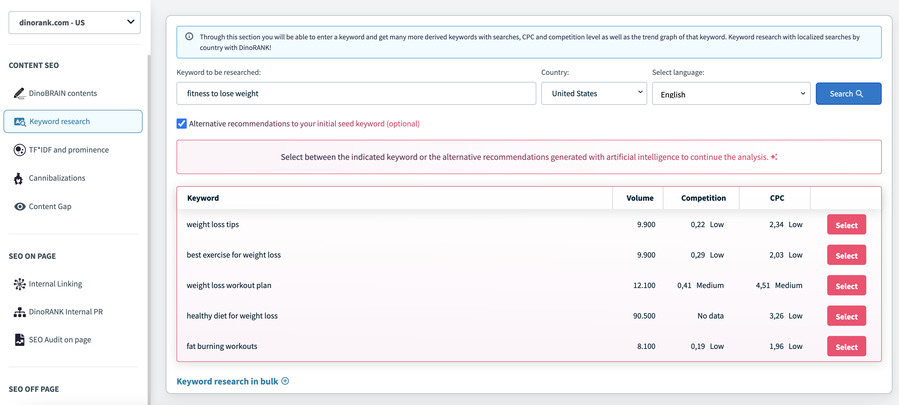
Remember, the key in each phase is to move on to the next stage. The keywords we’ve been working on are going to attract Miguel to our content.
But don’t forget that we need to make him convert.
Since they aren’t ready to make a purchase yet, we can turn them into a lead by getting them to sign up for our newsletter.
The lead magnet in this case will be the eBook titled “From Couch Potato to Fit in Just 10 Steps“.
As they both have weekends off, another example could be “The Top 7 Ways to Lose Weight by Exercising on the Weekends Only“. How does that sound?
With both, we’re addressing their pain points.
Regarding the keywords we can focus on in this first phase, here are more suggestions that ChatGPT has given me.
I’ll provide as detailed a prompt as possible. Something like this:

And these are the ideas it came back with.
You know the drill: analyze and verify that all of them are in the initial or awareness stage of the funnel and group them by search intentions.
Once you’ve got that, hit the excel!

In these contents, you should also encourage them to take action. It’s time to move on to the consideration stage.
For this, one option is to highlight success stories of people who are thriving and have incorporated that activity into their daily routine.
Taking ChatGPT’s suggestion number 2 from “How to Start Exercising When You Work from Home” as an example, you could share an actual case of individuals with a similar lifestyle who now feel healthier.
You can either share this real-life story yourself, or even better: have that person contribute to the content as a guest author.
Phase 2: Consideration Strategy
We’ve got it. Now Miguel is aware that we exist and that hiking is among the options he should consider.
Every Tuesday and Friday afternoon, he’ll receive an email with a specific sequence tailored to his needs, offering advice that adds value and gets him thinking.
Miguel is still ‘on the fence’ after learning more about hiking.
He knows what it is and the benefits it offers, so he decides to go on his first trail.
Before starting, he wants to know where to go without traveling too far, so one of his searches at this stage might be “Best hiking trails in San Diego”.
It was a no-brainer, right?
There you have to create a stellar article that gives Miguel a list of the best areas in San Diego for hiking.

The insights we pull from DinoRANK are incredibly powerful. Taking a look at this keyword, we notice that:
- Despite being a long tail, its search volume isn’t too shabby (1.000 searches/month)
- It faces low competition (great!)
- It exhibits significant seasonality. Being an outdoor activity, it’s less sought-after in summer, with interest peaking in spring and fall
After reading, he decides to hike the “Torrey Pines Hike” trail, located right in the mountains.
Miguel is getting excited and starts planning his route. That’s when he realizes an important detail:
What gear should I take with me to the mountains for hiking?
He hurries to Google something like “what to bring on a hiking trip”
He comes across your article “Essential Gear for a Hiking Trip” and compiles a list of items he needs to purchase, like backpacks, water bottles, or boots.
See where I’m going with SEO conversion and keywords?
At this stage, your articles should be guides and tutorials with advice that positions you as an authority on the topic and as someone trustworthy.
Moreover, this phase is dominated by long tails, as they represent more specific searches rather than generic ones.
If you’re short on ideas, ChatGPT can help you here as well:
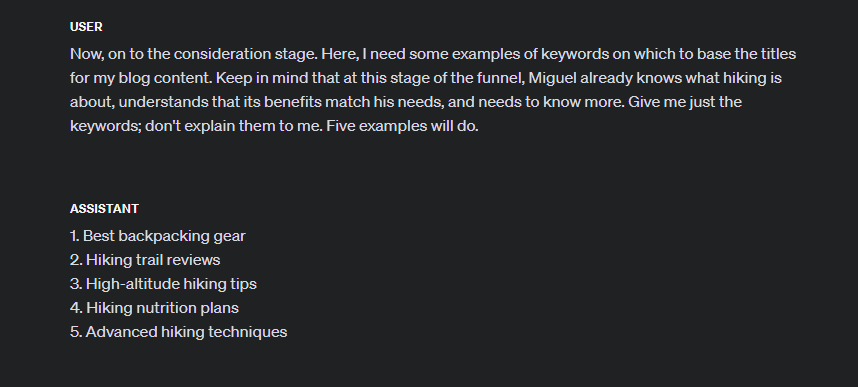
Within these contents, we must provide value to Miguel and answer what he is searching for with hiking already on his mind.
But it’s also time to persuade him with our SEO conversion strategy to take action and switch his mindset to ‘online shopping mode’.
How do we do that? Real-life examples that are as practical as possible can fit in really well here too.
When discussing “Hiking and Weight Loss“, you might share a detailed account of someone else’s success story.
For topics like “Top Hiking Trails Near San Diego”, provide geotagged links to actual trails and tips on what to expect at certain points along the way.
Tell them where to grab a bite without breaking the bank after finishing the trail and even where to stay overnight if it gets late and they prefer not to drive in the dark.
Ultimately, provide everything necessary to make that trail a ‘reality’ in Miguel’s mind and to spur him into action (purchasing gear to get started).
Phase 3: Decision Strategy
If you’ve made it to this phase, congratulations. You’re close to sealing the final deal.
To achieve this, you must continue to understand the Customer Journey:
At this point, Miguel knows he needs to buy equipment, like a good pair of hiking boots.
However, he hasn’t decided where to buy them or which ones to get, so he turns to the search engine with keywords like “best hiking boots”.
Let’s head back to DinoRANK 👇
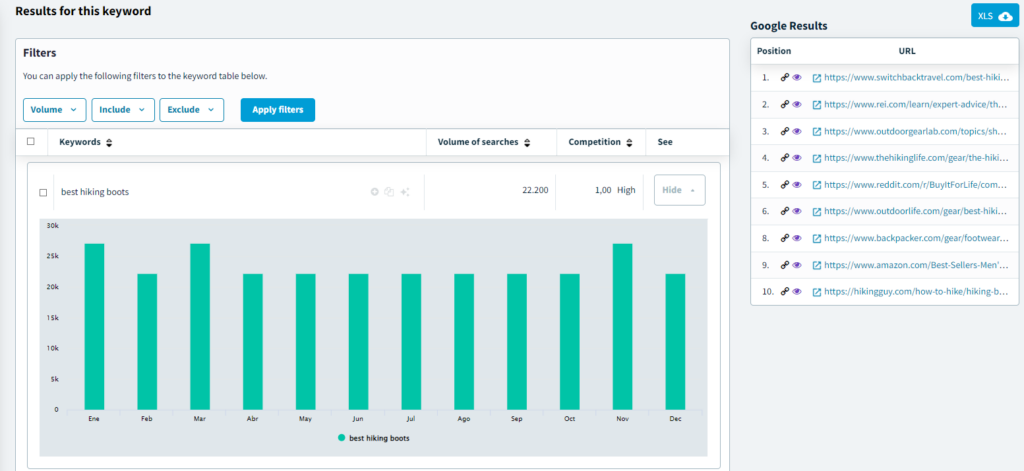
Notice that as the intent becomes more commercial, the competition tends to increase.
Additionally, if you look on the right side of the tool, you’ll start to see specialist websites positioning themselves with comparative content, where they ‘pit’ different types of products against each other, highlighting the strengths and weaknesses of each.
What’s interesting is that below this chart, DinoRANK gives you other derived keywords from the one you searched for.
This can give you some ‘more long-tail’ ideas to jot down in your Excel sheet during this phase.

Then, they will make a decision about which boots best suit their needs.
When it comes to making a purchase, where do you think they will buy?
On a website they’re visiting for the first time? Or on a site that has laid out a comparison for them, with real options based on features, benefits, and prices?
Phase 4: Loyalty Strategy
If you thought that making a sale of a pair of boots was the end of the line, I have to tell you that you are mistaken.
You still have the last and most difficult stage ahead: achieving repeat business.
Remember, it’s harder to acquire a new customer than to get a repeat purchase from one who has already bought from you.
The numbers speak for themselves: increasing customer retention rates by 5% can boost profits by 25% to 95%.
So, if you don’t want to have done all the groundwork only for the consumer to end up jumping ship to your competition, you need to continue optimizing this last stage of the customer journey:
At this point, Miguel has already completed his first trail and noticed that the boots were very comfortable. But he has realized that he needs other gear to enhance his new hobby.
Since you are already knowledgeable about hiking, there’s no need for someone to guide you.
Then you receive an email from your store announcing that you can get a 10% discount on future purchases with the code “LOYALCUSTOMER”.
And obviously, you’ll use it.
Benefits of Implementing a Conversion Funnel Strategy Through SEO
You’ve already found that following a strategy based on a conversion funnel, rather than trying to cut to the chase, is more labor-intensive.
However, the fact is that until you ‘roll up your sleeves’, listen to the initial problems your potential customer has, and help them by guiding them through the entire process, it will be difficult to achieve recurring sales.
- You save on advertising expenses, as it is a strategy based on unpaid organic traffic
- In a SEO funnel strategy, you will have control and the ability to know what the customer is looking for at each stage, so you can better optimize search intent.
- You’ll be able to identify at which phase most users drop off to improve it and nudge them to continue the journey.
- You’ll have more chances of achieving conversion at each stage and a final action of selling a product and/or service than if you don’t use a funnel strategy.
These are just some of the main benefits you will notice if you decide to carry out a conversion optimization strategy through SEO.
Believe me, from my experience, with a good SEO funnel, you will achieve everything sooner, at a lower cost, and according to your forecasts.

Now You Have What You Need to Optimize Your SEO Conversions
Once you have read this article and all the advice I have given you, you will be ready to improve your conversions with the help of SEO.
If you put into practice what you’ve learned, tailoring it to your industry, you’ll see that your results are much more positive.
Keep in mind that the most important thing is to put yourself in the consumer’s shoes and think about what they are looking for at each stage. Offer it to them in the clearest and simplest way possible, and you’ll be well on your way to success.

